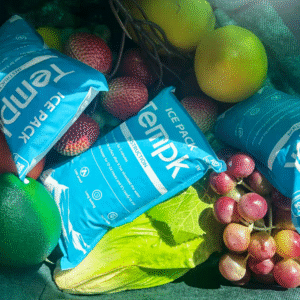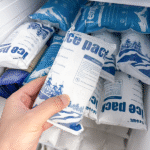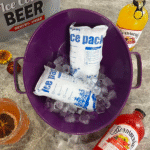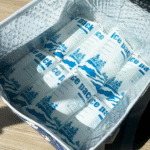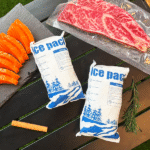Quantidade de gelo seco: Quanto você precisa em 2025?
Se você precisar de um jejum, Ponto de partida seguro para quantidade de gelo seco, Planeje em 5 a 10 lb por 24h e ajuste para isolamento, calor ambiente, e tamanho da carga útil. Para o ar, Use embalagem ventilada e marca E 1845 com o Massa de gelo seco da rede (kg) no pacote e no caminho do ar, quando necessário. USPS Air Mail está limitado em ≤5lb por peça. Validar todas as pistas com madeiras de dados antes de escalar.
-
Como dimensionar a quantidade de gelo seco rápido - com uma calculadora de cópia e use e regras de buffer
-
O que muda a quantidade de gelo seco - Isolamento, Pellets vs.. blocos, calor ambiente
-
2025 conformidade e etiquetas - e 1845, Classe9, e especificidades USPS/IATA
-
Pontos de partida de uso - Alimentos congelados, Biologics, e pistas ultracold
Como você calcula quantidade de gelo seco para sua pista?
Resposta curta: Multiplique os dias totais de trânsito por ~ 7,5 lb/dia (o ponto médio de 5-10), depois corrija para isolamento e estação, e adicione um buffer de atraso de 12 a 24h. Converter para kg para o seu rótulo. Validar em sua pista mais quente, Em seguida, afinar. Este método está alinhado com a orientação da operadora e os resultados dos testes do mundo real.
Por que funciona: O gelo seco esfria por sublimação a -78,5 ° C. Cada quilograma absorve grande energia à medida que se transforma em gás, agindo como uma poderosa "bateria fria". Melhores rotas de isolamento e mais frios vazam menos calor, Então você precisa de menos. Rotas mais quentes, espuma fina, e grandes vazios precisam de mais. Sempre desfeita o pacote Então o gás pode escapar.
Calculadora de quantidade de gelo seco que você pode copiar hoje
Dica: Comece um pouco alto, Em seguida, reduza quando seus madeireiros mostram margem nas faixas de verão. Blocos de carga superior, preencher vazios, e manter as aberturas claras.
| Planejando entrada | Faixa típica | Regra rápida | O que isso significa para você |
|---|---|---|---|
| Sublimação (mais frio) | 5–10lb / 24 h | Use a linha de base de 7,5 lb/dia | Adicione mais em clima quente ou espuma fina |
| Fator de isolamento | 0.7–1.3 | VIP = 0,7; EPS = 1,0; espuma fina = 1,3 | Melhores paredes → menos quantidade de gelo seco |
| Tempo de buffer | 12–24H | Adicionar após o tempo de rota | Capas atrasos e habitação de último milhão |
Dicas práticas que economizam falhas
-
Pré -condição tudo: Cargas úteis pré -congeladas; pré -escolar o interior do remetente.
-
Placação é importante: Carga superior gelo seco; ar frio afunda e melhora a eficiência.
-
Blocks vs.. Pellets: Pellets “cobrem” melhor; Os blocos duram mais em faixas de vários dias.
Caso do mundo real: Mudando de grânulos soltos de 10 lb para 12 lb misto Block -top + Pellet -perímetro cortar falhas quentes por 68% em julho e mantido ≤ -12 ° C para 54 h.
Quais fatores mudam a quantidade de gelo seco em remessas reais?
Ideia central: A carga de calor aciona a quantidade de gelo seco. Rotas mais longas, Ambiente mais quente, paredes finas, grandes vazios, e eventos frequentes de "porta -abertura" aumentam o número. Embalagens apertadas e melhor isolamento empurre -o para baixo. Nunca faça uma caixa hermética.
Pellets vs.. blocos: Impacto na quantidade de gelo seco
Blocos tem menos área de superfície e sublimado mais lento; Pellets evaporar mais rápido e precisar de mais massa para retenção de vários dias. Recipiente reutilizar pode aumentar a taxa de sublimação; Espere fazer um orçamento extra se os remetentes forem envelhecidos ou arranhados.
| Fator | Efeito típico | Como planejar | Para você |
|---|---|---|---|
| Tamanho do pellet | Menor → perda mais rápida | Prefere blocos para 48-72h | Segure mais, menos surpresas |
| Isolamento | VIP < Pir ≈ eps < espuma fina | Use o isolation_factor | Quantidade de gelo menos seco com VIP |
| Proporção de preenchimento | Alto preenchimento → menos convecção | Preencher vazios, Evite lacunas | Menor massa necessária |
| Perfil ambiente | Verão > inverno | Adicionar temporada_factor | Pistas quentes precisam de mais |
| Ventilação | Necessário para a segurança | Mantenha as aberturas claras | Evite o acúmulo de pressão |
Quantidade de gelo seco e 2025 conformidade - o que deve estar na caixa?
Para o ar: Ventive a embalagem e marca E 1845 (Gelo seco/dióxido de carbono, sólido), aplicar Classe9, e mostrar Massa de gelo seco na rede em kg no pacote; Inclua os detalhes necessários sobre o Air Waybill. USPS AIR: ≤ 5 Libra por correio. Limites de bagagem de passageiros (2.5 kg) Não restrinja a carga, mas ajude a explicar as diferenças para as partes interessadas.
Ar, chão, e correio de vista (2025)
| Modo | Regra -chave | Limite típico | O que isso significa |
|---|---|---|---|
| Ar (Aqui está o PI954) | Pacote ventilado; E 1845; Classe9; líquido kg marcado | Operador/aeronave -tipo dependente | Forneça kg líquido na reserva; Siga a lista de verificação de aceitação |
| NÓS. DOT/PHMSA (49 CFR173.217) | O pacote deve permitir a liberação de CO₂ | - | Design para ventilação; Rotule corretamente quando necessário |
| USPS (Publicação52, PI9AA) | Ventilado; Marcas; ar ≤5lb por peça | 5 Libra (ar) | Use superfície se acima de 5lb |
Segurança: Seguir Limites de exposição OSHA/NIOSH CO₂ (5,000 ppm twa; 30,000 ppm stel). Ventilate salas de matilha, vans, e caixas frias.
Quanta quantidade de gelo seco você deve começar por uso?
Matriz do planejador: Use estes Iniciando valores, Em seguida, valide com os registros de dados na pior temporada de sua pista.
| Caso de uso & Tempo de espera | Caixa/isolamento | Ambiente | Iniciando a quantidade de gelo seco | O que isso significa para você |
|---|---|---|---|---|
| Sorvete, 36 h | 1.5″ Eps | Leve | 12–15lb | Adicione 3–5lb se a última milha estiver quente |
| Massa congelada, 48 h | 1.5″ Eps | Verão | 20–25lb | Pellets de perímetro + Bloco superior |
| Frascos ultracold, 48 h | Remetente durável | Qualquer | 15–20lb | Rótulo un1845/classe9 com kg líquido |
| Kit de refeição (2–8 ° C.), 24 h | - | Quente | Prefira gel/pcm | Evite resfriamento excessivo & Etapas da DG |
Exemplos trabalhados:
-
Massa congelada, 5 kg, 36 h, EPS, quente → ~20 Libra (buffer)
-
Amostras −20 ° C., 3 kg, 24 h, VIP, leve → 8–10lb
-
Frascos ultracold, 6 kg, 60 h, EPS, quente → 28–30lb com validação de logger
2025 Desenvolvimentos e tendências no planejamento da quantidade de gelo seco
O que há de novo: Operadores solicitam cada vez mais Net KG na reserva para gerenciar limites de CO₂ no nível da aeronave. Testes recentes destacam como Tamanho do pellet, Design de contêiner, e reutilizar Alterar taxa de sublimação, Portanto, sua linha de base “8lb/dia” é boa para o planejamento, mas deve ser validada. Os carregadores de comida e D2C estão adotando embalagens híbridas (PCM Core + Topper pequeno de gelo seco) Para reduzir o atrito da DG e o risco de destinatário.
Último progresso em um olhar
-
Taxas acionadas por dados: Os testes mais recentes quantificam como os pellets e a reutilização aumentam a perda - plano conservador para remetentes idosos.
-
Clareza da transportadora: Publicado 5-10lb/dia de planejamento de orientação vinculada a isolamento e condições ambientais.
-
Reforço de segurança: Lembretes mais claros sobre ventilação e rotulagem para a UN1845/classe9.
Insight de mercado: Pistas refrigeradas/molas PCM/gel sozinho; usando a Topper pequeno de gelo seco Somente para picos de calor pode reduzir a massa total de refrigerante e simplificar a rotulagem.
Perguntas frequentes
Quanta quantidade de gelo seco por dia devo planejar um pequeno refrigerador?
Comece com 5–10lb por 24h e adicione 20–30% buffer Para atrasos e picos de calor; preferir blocos para retenção de vários dias.
Preciso de uma declaração de remetente quando o gelo seco é apenas um refrigerante?
Muitas vezes não Aqui está aqui, Mas você deve marcar E 1845, aplicar Classe9, e mostrar NET KG no pacote e AWB, quando necessário.
USPS Air Limited?
Sim. USPS ar é ≤5lb por correio; Pacotes mais pesados devem se mover pela superfície.
Pode secar a comida de gelo touch?
Evite contato direto. Use separadores e forneça instruções de manuseio de destinatários.
E a exposição do trabalhador?
Seguir 5,000 ppm twa e 30,000 ppm stel Limites co₂; Ventilar áreas de estadiamento e veículos.
Grearia de autoconfiança acionável: A sua quantidade de gelo seco no alvo?
-
Horário de rota são porta -porta, não apenas o transportador SLA
-
Buffer de 12–24H adicionado para atrasos
-
Isolation_factor reflete sua especificação de caixa (VIP0.7 / EPS1.0 / espuma fina1.3)
-
Pacote ventilado; marcado E 1845 / Classe9 / NET KG quando necessário
-
Segurança alimentar: ≤40 ° F. (4 ° c) Através da última milha, Verificado por Logger
Resumo & Recomendações
Takeaways -chave: Iniciar a quantidade de gelo seco em 5–10lb/dia, correto para isolamento e ambiente, adicionar 12–24H buffer, e Rótulo un1845/classe9 com kg líquido quando necessário. Preferir blocos Por muito tempo; ventilação cada pacote; validar Sob sua pior pista sazonal antes de escalar.
PRÓXIMOS PASSOS:
-
Execute dois pilotos por pista (linha de base vs.. +20% massa).
-
Temperatura de log de armazém a porta e sintonizar.
-
Luque os poços para colocação, ventilação, rótulos, e buffers.
-
Considerar Híbridos PCM Para reduzir o atrito de Hazmat em pistas frias/moldes.
Sobre Tempk
Nós projetamos, teste, e padronizar embalagens passivas de cadeia fria para ciências alimentares e de vida. Nossa equipe é especializada em quantidade de gelo seco modelagem, Validação da pista (Perfis ISTA), e treinamento de conformidade. Os clientes reduzem a deterioração e o custo com dimensionamento preciso, melhor isolamento, e POPS CLEAR. Precisa de um plano específico de pista? Solicitar a 20Auditoria de minuto de minuto e obter um design testado - rápido.






